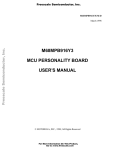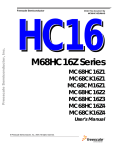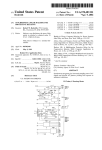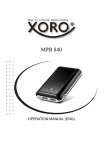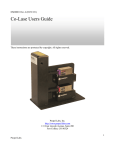Download M68MPB16Z3 MCU PERSONALITY BOARD USER`S MANUAL
Transcript
Freescale Semiconductor, Inc. M68MPB16Z3UM/D Freescale Semiconductor, Inc... February 1998 M68MPB16Z3 MCU PERSONALITY BOARD USER’S MANUAL © MOTOROLA, INC., 1994, 1998; All Rights Reserved For More Information On This Product, Go to: www.freescale.com Freescale Semiconductor, Inc... Freescale Semiconductor, Inc. Motorola reserves the right to make changes without further notice to any products herein to improve reliability, function or design. Motorola does not assume any liability arising out of the application or use of any product or circuit described herein; neither does it convey any license under its patent rights nor the rights of others. Motorola products are not designed, intended, or authorized for use as components in systems intended for surgical implant into the body, or other applications intended to support or sustain life, or for any other application in which the failure of the Motorola product could create a situation where personal injury or death may occur. Should Buyer purchase or use Motorola products for any such unintended or unauthorized application, Buyer shall indemnify and hold Motorola and its officers, employees, subsidiaries, affiliates, and distributors harmless against all claims, costs, damages, and expenses, and reasonable attorney fees arising out of, directly or indirectly, any claim of personal injury or death associated with such unintended or unauthorized use, even if such claim alleges that Motorola was negligent regarding the design or manufacture of the part. Motorola and the Motorola logo are registered trademarks of Motorola Inc. SDI is a trademark of Motorola Inc. Motorola Inc. is an Equal Opportunity/Affirmative Action Employer. For More Information On This Product, Go to: www.freescale.com Freescale Semiconductor, Inc. CONTENTS CONTENTS Freescale Semiconductor, Inc... CHAPTER 1 GENERAL INFORMATION 1.1 1.2 1.3 1.4 INTRODUCTION .............................................................................................................. 1-1 SPECIFICATIONS............................................................................................................. 1-2 EQUIPMENT REQUIRED ................................................................................................ 1-2 CUSTOMER SUPPORT .................................................................................................... 1-3 CHAPTER 2 HARDWARE PREPARATION AND INSTALLATION 2.1 2.2 INTRODUCTION .............................................................................................................. 2-1 HARDWARE PREPARATION......................................................................................... 2-1 2.2.1 Clock Select Header (W1) ......................................................................................... 2-4 2.2.2 VDDA Select Header (W2) ....................................................................................... 2-5 2.2.3 Voltage Reference High Select Header (W3)............................................................ 2-6 2.2.4 Voltage Reference Low Select Header (W4)............................................................. 2-7 2.2.5 MCU ID Code Select Header (W6, W7, W8, W9, W10).......................................... 2-8 2.2.6 VSSA Insertion Point (E1) ........................................................................................ 2-8 2.3 MEVB CONFIGURATION............................................................................................... 2-9 2.4 ACTIVE PROBE CONFIGURATION............................................................................ 2-11 CHAPTER 3 MEVB QUICK START GUIDE 3.1 3.2 INTRODUCTION .............................................................................................................. 3-1 CONFIGURING THE MPFB............................................................................................. 3-1 3.2.1 MPFB Memory Devices ............................................................................................ 3-1 3.2.2 MPFB Jumper Headers.............................................................................................. 3-2 3.3 MEVB INSTALLATION INSTRUCTIONS ..................................................................... 3-3 3.3.1 Power Supply – MPFB Connection........................................................................... 3-4 3.3.2 Personal Computer – BDM Connection .................................................................... 3-5 3.4 SOFTWARE INSTALLATION AND MCU INITIALIZATION...................................... 3-5 M68MPB16Z3UM/D For More Information On This Product, Go to: www.freescale.com iii Freescale Semiconductor, Inc. CONTENTS CHAPTER 4 MEVB SUPPORT INFORMATION 4.1 4.2 INTRODUCTION .............................................................................................................. 4-1 LOGIC ANALYZER CONNECTOR SIGNALS............................................................... 4-1 CHAPTER 5 MAPI SUPPORT INFORMATION Freescale Semiconductor, Inc... 5.1 5.2 INTRODUCTION .............................................................................................................. 5-1 MAPI BUS CONNECTORS.............................................................................................. 5-1 CHAPTER 6 SCHEMATIC DIAGRAMS 6.1 INTRODUCTION .............................................................................................................. 6-1 FIGURES 2-1. 2-2. 2-3. 5-1. 5-2. 5-3. 5-4. 5-5. MPB Parts Location Diagram (top view) ........................................................................... 2-2 MPB – MPFB Interconnection (with SDI interface connector) ....................................... 2-10 Active Probe Interconnection (with Active Probe Box)................................................... 2-12 MAPI Interface Connector Layout...................................................................................... 5-1 MAPI Interface Connector P1 Pin Assignments ................................................................ 5-2 MAPI Interface Connector P2 Pin Assignments ................................................................ 5-3 MAPI Interface Connector P3 Pin Assignments ................................................................ 5-4 MAPI Interface Connector P4 Pin Assignments ................................................................ 5-5 TABLES 1-1. 2-1. 2-2. 3-1. 4-1. 4-2. 4-3. 4-4. 4-5. 4-6. iv MPB Specifications ............................................................................................................ 1-2 Jumper Header Types ......................................................................................................... 2-3 MPB Jumper Header Descriptions ..................................................................................... 2-3 MPFB Quick Start Jumper Header Configuration.............................................................. 3-2 Logic Analyzer Connector J7 Pin Assignments ................................................................. 4-2 Logic Analyzer Connector J8 Pin Assignments ................................................................. 4-2 Logic Analyzer Connector J9 Pin Assignments ................................................................. 4-3 Logic Analyzer Connector J10 Pin Assignments ............................................................... 4-3 Logic Analyzer Connector J11 Pin Assignments ............................................................... 4-4 Logic Analyzer Connector J12 Pin Assignments ............................................................... 4-4 For More Information On This Product, Go to: www.freescale.com M68MPB16Z3UM/D Freescale Semiconductor, Inc. CONTENTS Freescale Semiconductor, Inc... TABLES (continued) 4-7. Logic Analyzer Connector J13 Pin Assignments ............................................................... 4-6 4-8. Logic Analyzer Connector J14 Pin Assignments ............................................................... 4-8 4-9. Logic Analyzer Connector J15 Pin Assignments ............................................................... 4-9 4-10. Logic Analyzer Connector J16 Pin Assignments ............................................................... 4-9 4-11. Logic Analyzer Connector J17 Pin Assignments ............................................................. 4-10 4-12. Logic Analyzer Connector J18 Pin Assignments ............................................................. 4-11 4-13. Logic Analyzer Connector J19 Pin Assignments ............................................................. 4-12 4-14. Logic Analyzer Connector J20 Pin Assignments ............................................................. 4-12 M68MPB16Z3UM/D For More Information On This Product, Go to: www.freescale.com v Freescale Semiconductor, Inc. Freescale Semiconductor, Inc... CONTENTS vi For More Information On This Product, Go to: www.freescale.com M68MPB16Z3UM/D Freescale Semiconductor, Inc. GENERAL INFORMATION CHAPTER 1 GENERAL INFORMATION Freescale Semiconductor, Inc... 1.1 INTRODUCTION This manual provides general information, hardware preparation, installation instructions, a quick start guide, support information, and schematic diagrams for the M68MPB16Z3 MCU Personality Board (MPB). The MPB is one component of Motorola’s modular approach to MC68HC16Z3 Microcontroller Unit-based product development. This modular approach lets you easily configure our development systems to fit your requirements. The MPB may be used in either the MMDS1632 Motorola Modular Development System (MMDS) or the modular evaluation board (MEVB). The MEVB consists of the M68MPFB Modular Platform Board (MPFB) and an MPB. Alternately, you may install the MPB directly in your target system if the target system includes a modular active probe interconnect (MAPI) interface. The MCU device on the MPB defines which MCU is emulated/evaluated by the MMDS or evaluated by the MEVB. Both systems are invaluable tools for designing, debugging, and evaluating MCU operation of the M68HC12, M68HC16, and M68300 MCU families. By providing the essential MCU timing and I/O circuitry, these systems simplify user evaluation of prototype hardware/software products. The MPB includes: • M68MPB16Z3 MCU Personality Board (MPB) • Plastic overlay for use with the MEVB – pin outs for the logic analyzer connectors on the MPFB (the overlay for this MPB is the same one used with the M68MPB16Z1) • Documentation (this manual) M68MPB16Z3UM/D For More Information On This Product, Go to: www.freescale.com 1-1 Freescale Semiconductor, Inc. GENERAL INFORMATION 1.2 SPECIFICATIONS Table 1-1 lists MPB specifications. Table 1-1. MPB Specifications Freescale Semiconductor, Inc... Characteristic Specifications On-Board Clock Case style: 14- or 8-pin hybrid crystal clock oscillator (frequency as required by MCU). External Clock 32 KHz – 16.78 MHz (or maximum MCU allows). MCU I/O ports HCMOS compatible Temperature Operating Storage 0° to +40° C -40° to +85° C Relative humidity 0 to 90% (non-condensing) Power requirements +5Vdc ± 5% @ 500 mA (max.) Dimensions MCU Personality Board 3.25 x 3.25 in. (82.6 x 82.6 mm) 1.3 EQUIPMENT REQUIRED The external requirements for MPB operation are either an MEVB or MMDS system. For MMDS operation requirements, see the MMDS1632 Motorola Modular Development System User’s Manual, MMDS1632UM/D. For operation requirements for the MEVB, see this manual and the M68MPFB Modular Platform Board User’s Manual, M68MPFBUM/D. 1-2 For More Information On This Product, Go to: www.freescale.com M68MPB16Z3UM/D Freescale Semiconductor, Inc. GENERAL INFORMATION 1.4 CUSTOMER SUPPORT For information about a Motorola distributor or sales office near you call: Freescale Semiconductor, Inc... AUSTRALIA, Melbourne – (61-3)887-0711 Sydney – 61(2)906-3855 BRAZIL, Sao Paulo – 55(11)815-4200 CANADA, B. C., Vancouver – (604)606-8502 ONTARIO, Toronto – (416)497-8181 ONTARIO, Ottawa – (613)226-3491 QUEBEC, Montreal – (514)333-3300 JAPAN, Fukuoka – 81-92-725-7583 Gotanda – 81-3-5487-8311 Nagoya – 81-52-232-3500 Osaka – 81-6-305-1802 Sendai – 81-22-268-4333 Takamatsu – 81-878-37-9972 Tokyo – 81-3-3440-3311 KOREA, Pusan – 82(51)4635-035 Seoul – 82(2)554-5118 CHINA, Beijing – 86-10-68437222 MALAYSIA, Penang – 60(4)2282514 DENMARK – (45)43488393 FINLAND, Helsinki – 358-9-6824-400 MEXICO, Mexico City – 52(5)282-0230 Guadalajara – 52(36)21-8977 FRANCE, Paris – 33134 635900 PUERTO RICO, San Juan – (809)282-2300 GERMANY, Langenhagen/Hannover – 49(511)786880 Munich – 49 89 92103-0 Nuremberg – 49 911 96-3190 Sindelfingen – 49 7031 79 710 Wiesbaden – 49 611 973050 SINGAPORE – (65)4818188 HONG KONG, Kwai Fong – 852-6106888 Tai Po – 852-6668333 SPAIN, Madrid – 34(1)457-8204 SWEDEN, Solna – 46(8)734-8800 SWITZERLAND, Geneva – 41(22)799 11 11 Zurich – 41(1)730-4074 TAIWAN, Taipei – 886(2)717-7089 INDIA, Bangalore – (91-80)5598615 THAILAND, Bangkok – 66(2)254-4910 ISRAEL, Herzlia – 972-9-590222 UNITED KINGDOM, Aylesbury – 441(296)395-252 ITALY, Milan – 39(2)82201 UNITED STATES, Phoenix, AZ – 1-800-441-2447 For a list of the Motorola sales offices and distributors: 0http://www.mcu.motsps.com/sale_off.html M68MPB16Z3UM/D For More Information On This Product, Go to: www.freescale.com 1-3 Freescale Semiconductor, Inc. Freescale Semiconductor, Inc... GENERAL INFORMATION 1-4 For More Information On This Product, Go to: www.freescale.com M68MPB16Z3UM/D Freescale Semiconductor, Inc. HARDWARE PREPARATION AND INSTALLATION CHAPTER 2 HARDWARE PREPARATION AND INSTALLATION Freescale Semiconductor, Inc... 2.1 INTRODUCTION This chapter provides unpacking instructions, hardware preparation information, and installation instructions for the MPB. When you unpack the MPB from its shipping carton, verify that all items are in good condition. Save packing material for storing and shipping the MPB. NOTE Should the MPB arrive damaged, save all packing material, and contact the carrier’s agent. 2.2 HARDWARE PREPARATION This portion of the manual explains how to prepare the MPB before use, as well as how to configure the MPB for system operation. This section also explains MPB installation in the MMDS and MEVB. The MPB has been factory tested and is shipped with installed jumpers. A jumper installed on a jumper header provides a connection between two points in the MPB circuit. The MPB has two types of jumper headers: three-pin and two-pin with a cut-trace short. A cut-trace short has a copper trace between the feedthrough holes (bottom or solder side of the MPB). Table 2-1 describes each type of jumper header. The MPB has nine jumper headers (for which Table 2-2 is a quick reference guide). You may reconfigure these jumper headers to customize MPB functionality. The following paragraphs explain each jumper header function. There is also an insertion point (E1) for connecting an external ground. NOTE Verify that all socketed parts are seated in their sockets. M68MPB16Z3UM/D For More Information On This Product, Go to: www.freescale.com 2-1 Freescale Semiconductor, Inc. HARDWARE PREPARATION AND INSTALLATION CAUTION Depending on your application, it may be necessary to cut the W2 wiring trace short (cut-trace short). Be careful not to cut adjacent PCB traces, nor cut too deep into the multi-layer circuit board. Freescale Semiconductor, Inc... If the cut-trace short on a jumper header is already cut, you can return the MPB to its default setting by installing a user-supplied fabricated jumper. Figure 2-1. MPB Parts Location Diagram (top view) 2-2 For More Information On This Product, Go to: www.freescale.com M68MPB16Z3UM/D Freescale Semiconductor, Inc. HARDWARE PREPARATION AND INSTALLATION Table 2-1. Jumper Header Types Freescale Semiconductor, Inc... Jumper Header Type Symbol Description two-pin with cut-trace short Two-pin jumper header with cut-trace short, designated WX, where X = the jumper header number. If you cut the short, use a fabricated jumper to return the jumper header to its factory default state. three-pin Three-pin jumper header, designated WX, where X = the jumper header number. Use a fabricated jumper to create a connection between two of the three pins of the jumper header. Table 2-2. MPB Jumper Header Descriptions Jumper Header W1 W2 Type Description 1 2 3 Jumper between pins 1 and 2 (factory default); selects the MPB on-board crystal clock source. 1 2 Jumper installed or cut-trace short intact (factory default); selects the on-board VDDA power source. Jumper between pins 2 and 3; selects an external clock source to be the MCU EXTAL input signal. No jumper or cut-trace short; lets you connect an external power source to W2 pin 2 and the external-power-source ground to E1. NOTE Jumper header W2 is not populated by the factory. W3 W4 W6 – W10 1 2 3 Jumper installed on pins 1 and 2 (factory default); selects the MPB on-board VRH power source. 1 2 3 Jumper installed on pins 1 and 2 (factory default); selects the MPB on-board VRL power source. 1 2 3 Configure the jumpers on jumper headers W6 through W10 to define which MCU is evaluated/emulated; MC68HC16Z1, MC68HC16Z2, MC68HC16Z3, and MC68HC16Z4. See paragraph 2.2.5 for more information. M68MPB16Z3UM/D Jumper installed on pins 2 and 3; selects external VRH power source. Jumper installed on pins 2 and 3; selects external VRL power source. For More Information On This Product, Go to: www.freescale.com 2-3 Freescale Semiconductor, Inc. HARDWARE PREPARATION AND INSTALLATION 2.2.1 Clock Select Header (W1) Freescale Semiconductor, Inc... Jumper header W1 connects the MCU external clock (EXTAL) pin to either an on-board or external (target-system) clock source. The drawing below shows the factory configuration: a fabricated jumper on pins 1 and 2. This configuration selects the MPB on-board clock source; crystal oscillator in the Y1 socket. (This crystal provides for operation at the maximum rate the MCU allows via the internal phase-locked loop or direct clock input.) If you install the MPB in the active probe or directly on a target system, and use the target system clock as the MPB clock, move the fabricated jumper to W1 pins 2 and 3. This connects the MCU EXTAL pin to the MAPI bus input pin. The frequency of the external clock signal can be from 32 KHz to 16.78 MHz (or to the maximum the MCU allows). W1 1 2 3 NOTE You cannot drive the MPB clock circuit from an external source (target system) with a discrete crystal. If you use a target system clock source to drive the MPB clock circuit, always use a logicdriven clock such as a hybrid oscillator. 2-4 For More Information On This Product, Go to: www.freescale.com M68MPB16Z3UM/D Freescale Semiconductor, Inc. HARDWARE PREPARATION AND INSTALLATION 2.2.2 VDDA Select Header (W2) Freescale Semiconductor, Inc... Jumper header W2 selects the MPB VDDA power source: either MPB power (VDDI) or an external source. The drawing below shows the factory configuration: a cut-trace short between pins 1 and 2. This configuration connects filtered VDDI to VDDA. To use an external power source, remove the cut-trace short from W2 pins 1 and 2, then connect the external power source to W2 pin 2. Removal of the cut-trace short isolates the MCU VDDA pin from the other MPB circuitry. Isolation lets you connect a precision VDDA source for accurate 10-bit analog/digital (A/D) generation. When connecting an external VDDA power supply to the MPB, connect the power supply ground to insertion point E1. For more information on A/D generation refer to the Analog-To-Digital Converter Reference Manual, ADCRM/AD. W2 1 2 NOTES If the cut-trace short has been cut, you must install a fabricated jumper on W2 to return it to the factory configuration. Jumper header W2 is not populated by the factory. M68MPB16Z3UM/D For More Information On This Product, Go to: www.freescale.com 2-5 Freescale Semiconductor, Inc. HARDWARE PREPARATION AND INSTALLATION 2.2.3 Voltage Reference High Select Header (W3) Jumper header W3 selects the voltage reference high (VRH) source: either MPB power (VDDA) or an external VRH source. The drawing below shows the factory configuration: a fabricated jumper on pins 1 and 2. This configuration selects VDDA as the VRH source. Freescale Semiconductor, Inc... To use an external VRH source, first place the fabricated jumper on W3 pins 2 and 3. Then connect the MCU VRH pin to the external VRH source. Each configuration defines the best method for connecting the MCU VRH pin to the external VRH source: • MPB/MPFB – connect via the MPFB logic analyzer connector (refer to Chapter 4 for the appropriate logic analyzer pin). • MPB/MMDS1632 – connect via the VRH pin of the target MCU socket. • MPB/Target System – connect via the VRH pin of the target system MAPI bus. Alternately, you may remove the jumper and wire-wrap directly to W3 pin 2. Connecting directly to pin 2 is an option regardless of the configuration. W3 1 2 3 2-6 For More Information On This Product, Go to: www.freescale.com M68MPB16Z3UM/D Freescale Semiconductor, Inc. HARDWARE PREPARATION AND INSTALLATION 2.2.4 Voltage Reference Low Select Header (W4) Freescale Semiconductor, Inc... Jumper header W4 selects the voltage reference low (VRL) source: either MPB power (VSSA) or an external VRL source. The drawing below shows the factory configuration: a fabricated jumper on pins 1 and 2. This configuration selects VSSA as the VRL source. To use an external VRL source, first place the fabricated jumper on W4 pins 2 and 3. Then connect the MCU VRL pin to the external VRL source. Each configuration defines the best method for connecting the MCU VRL pin to the external VRL source: • MPB/MPFB – connect via the MPFB logic analyzer connector (refer to Chapter 4 for the appropriate logic analyzer pin). • MPB/MMDS1632 – connect via the VRL pin of the target MCU socket. • MPB/Target System – connect via the VRL pin of the target system MAPI bus. Alternately, you may remove the jumper and wire-wrap directly to W4 pin 2. Connecting directly to pin 2 is an option regardless of the configuration. W4 1 2 3 M68MPB16Z3UM/D For More Information On This Product, Go to: www.freescale.com 2-7 Freescale Semiconductor, Inc. HARDWARE PREPARATION AND INSTALLATION 2.2.5 MCU ID Code Select Header (W6, W7, W8, W9, W10) Freescale Semiconductor, Inc... Configure jumper headers W6, W7, W8, W9 & W10 to define which MCU is emulated by the MPB; either the MC68HC16Z1, MC68HC16Z2, MC68HC16Z3, or MC68HC16Z4 MCU. The drawing below shows the configuration for the MC68HC16Z3. To use the MPB with an different MCU installed, configure the fabricated jumpers per the table below. W6 W7 W9 W10 1 1 1 1 1 2 2 2 2 2 3 3 3 3 3 MCU (U2) 2.2.6 W8 W6 W7 W8 W9 W10 MC68HC16Z1 1–2 1–2 1–2 2–3 1–2 MC68HC16Z2 2–3 2–3 1–2 1–2 2–3 MC68HC16Z3 2–3 2–3 1–2 2–3 2–3 MC68HC16Z4 1–2 2–3 2–3 1–2 1–2 VSSA Insertion Point (E1) Insertion point E1 is a plate through hole that lets you connect an external ground to the MPB VSSA pin (refer to paragraph 2.2.2). Insert an external ground wire in E1 and solder it into the plate through hole. NOTE Insertion point E1 is not populated by the factory. 2-8 For More Information On This Product, Go to: www.freescale.com M68MPB16Z3UM/D Freescale Semiconductor, Inc. HARDWARE PREPARATION AND INSTALLATION 2.3 MEVB CONFIGURATION The MEVB contains: Freescale Semiconductor, Inc... • MPB – MCU-device-specific board that defines the MCU to be evaluated. • M68MPFB1632 Modular Platform Board (MPFB) – which provides the interface connections to the host computer, logic analyzer connections, and the platform for installing the MPB. For more information about the MPFB and MEVB system connections refer to the M68MPFB1632 Modular Platform Board User's Manual, M68MPFB1632/D. Chapter 3 of this manual contains information to help you get started using your MEVB. CAUTION Turn OFF MPFB power when installing the MPB on the MPFB or removing the MPB from the MPFB. Sudden power surges could damage MEVB integrated circuits. To install the MPB on the MPFB (refer to Figure 2-2): 1. Inspect all connectors for bent or damaged pins. 2. Align the MPB reference mark with the MPFB reference mark. 3. Rotate the MPB until the four MAPI bus connectors on its bottom mate with the MAPI bus connectors on the top of the MPFB. (There is only one way to connect the MPB and the MPFB.) 4. Firmly press the MPB onto the MPFB. CAUTION Support the bottom side of MPFB when installing the MPB on the MPFB. Excessive flexing of the MPFB could damage the printed circuit. M68MPB16Z3UM/D For More Information On This Product, Go to: www.freescale.com 2-9 Freescale Semiconductor, Inc. Freescale Semiconductor, Inc... HARDWARE PREPARATION AND INSTALLATION Figure 2-2. MPB – MPFB Interconnection (with SDI interface connector) After you have installed the MPB, install the plastic overlay on the MPFB: place the overlay over logic analyzer connectors J12 through J20 and press down. Holes in the overlay slide down over plastic clips on the MPFB. These clips hold the overlay in place. 2-10 For More Information On This Product, Go to: www.freescale.com M68MPB16Z3UM/D Freescale Semiconductor, Inc. HARDWARE PREPARATION AND INSTALLATION 2.4 ACTIVE PROBE CONFIGURATION The M68MMDS1632 Motorola Modular Development System (MMDS) consists of the station module and an active probe. The active probe consists of a three board set, two cables, and a box: Freescale Semiconductor, Inc... • MPB – MCU-device-specific board that defines the MCU to be evaluated. • Enhanced Target Control Board (TCBe) – the interface between the MPB, target system, and the station module. The TCBe must be purchased separately. For more information about the TCBe refer to the MMDS1632 Motorola Modular Development System User's Manual, MMDS1632UM/D. • Package Personality Board (PPB) – the board that connects the active probe to the target system. The PPB must be purchased separately. For more information about the PPB refer to the appropriate PPB configuration guide. • Active probe cables (2) – the interface between the active probe and the station module. 01-RE90340W01 REV 0 and 01-RE90341W01 REV 0 are printed on the active probe cables. The active probe cables come with the TCBe. For more information about the active probe cables refer to the MMDS1632 Motorola Modular Development System User's Manual, MMDS1632UM/D. • Active probe box – the protective enclosure for the TCBe. CAUTION Turn off MMDS and target system power when installing or removing MMDS components. Sudden power surges could damage MMDS and target system integrated circuits. To configure an active probe (refer to Figure 2-3): 1. Inspect all connectors for bent or damaged pins. 2. Rotate the MPB until the four MAPI bus connectors on its bottom mate with the MAPI bus connectors on the top of the TCBe. (There is only one way to connect the MPB and the TCBe.) Firmly press the MPB and the TCBe together. 3. Rotate the PPB until the four MAPI bus connectors on its top mate with the MAPI bus connectors on the bottom of the TCBe. (There is only one way to connect the PPB and the TCBe.) Firmly press the PPB and the TCBe together. M68MPB16Z3UM/D For More Information On This Product, Go to: www.freescale.com 2-11 Freescale Semiconductor, Inc. HARDWARE PREPARATION AND INSTALLATION 4. Connect one end of the 01-RE90341W01 REV 0 active probe cable to connector P6 on the MMDS control board; connect the other end to connector J6 on the TCBe. Connect one end of the 01-RE90340W01 REV 0 active probe cable to connector P5 on the MMDS control board; connect the other end to connector J5 on the TCBe. Secure the connector clamps on TCBe connectors J5 and J6. Freescale Semiconductor, Inc... The active probe is now ready to connect to the target system (refer to the PPB configuration guide for information on connecting the active probe to the target system.) Figure 2-3. Active Probe Interconnection (with Active Probe Box) 2-12 For More Information On This Product, Go to: www.freescale.com M68MPB16Z3UM/D Freescale Semiconductor, Inc. MEVB QUICK START GUIDE CHAPTER 3 MEVB QUICK START GUIDE Freescale Semiconductor, Inc... 3.1 INTRODUCTION This quick start guide is intended for the user who may not be familiar with Motorola’s development tools. This chapter explains the MEVB hardware and software set-up for M68MEVB16Z3 operation. Hardware set-up consists of configuring the MPB and MPFB jumper headers; software set-up consists of installing and running the appropriate macro script file within the debugger. For the purpose of this quick start guide the MPB jumper headers should be configured in their default positions. Chapter 2 of this manual contains the default jumper header settings for the MPB. 3.2 CONFIGURING THE MPFB The MPFB includes jumper-selectable options such as chip select usage, memory type selection and memory size selection for the pseudo ROM sockets, and reset data control. NOTE The MPFB must be configured for the specific MPB. Paragraph 3.2.2 provides a configuration for basic MPFB operation. For a detailed description of the MPFB jumper header selections refer to the M68MPFB Modular Platform Board User’s Manual, M68MPFBUM/D. 3.2.1 MPFB Memory Devices Pseudo ROM refers to memory locations U2 & U4. The two pseudo ROM sockets are generic memory sockets that accept a variety of RAM, EPROM, or EEPROM devices. The pseudo ROM sockets, as shipped from the factory, contain two 32K x 8 RAM devices. These memories are 28-pin package devices. M68MPB16Z3UM/D For More Information On This Product, Go to: www.freescale.com 3-1 Freescale Semiconductor, Inc. MEVB QUICK START GUIDE 3.2.2 MPFB Jumper Headers Configure your MPFB jumper headers per the instructions in Table 3-1. Table 3-1 contains information exclusively intended for quick start and ignores the other jumper headers. Freescale Semiconductor, Inc... Table 3-1. MPFB Quick Start Jumper Header Configuration Jumper Header Type Description W2 123 Install a jumper on pins 1 and 2 to configure pin 1 of the memory devices in the pseudo ROM sockets (U2 & U4) as a standard address line. W3 123 Install a jumper on pins 1 and 2 to indicate that the memory devices in the pseudo ROM sockets (U2 & U4) have 28 pins. W4 123 Install a jumper on pins 1 and 2 to set the pseudo ROM port size (memory data width) as word. W5 123 Install a jumper on pins 2 and 3 to enable the PRU. W6 123 W6 selects the MCU operation mode. Each 3-pin jumper header set corresponds to an MCU data line. While the reset pin is low, the reset data values are driven on the data bus (D0 – D15). (The MEVB reset data circuit is open drain; a high state is provided via a pull-up resistor.) Each reset data line may be set high (H) or low (L). Consult the appropriate MCU user's manual, data book, or technical summary for reset data information. W10 1 3 5 2 4 6 Install a jumper on pins 1 and 2 to indicate that RAM is installed in the pseudo ROM sockets (U2 & U4). W12 1 3 5 7 9 2 4 6 8 10 Install a jumper on pins 3 and 4 to indicate that the two devices installed in the pseudo ROM sockets (U2 & U4) are 32K x 8. 3-2 For More Information On This Product, Go to: www.freescale.com M68MPB16Z3UM/D Freescale Semiconductor, Inc. MEVB QUICK START GUIDE Table 3-1. MPFB Quick Start Jumper Header Configuration (continued) Jumper Header Freescale Semiconductor, Inc... W14 Type 123 Description Jumper header W14 selects the MCU signal for the memory devices in the fast RAM sockets (U9 & U10) and pseudo ROM sockets (U2 & U4). Pins 1 and 2 select the MCU chip select for the memory devices in the fast RAM sockets. Pins 2 and 3 of jumper header W14 select the chip select for the memory devices in the pseudo ROM sockets. Jumper installed on CSBOOT pins 2 and 3 (factory default); use CSBOOT as the memory device chip enable for memory devices in the pseudo ROM sockets. W16 12 No jumper installed; the MCU MODCLK signal is pulled high (logic 1) via a resistor during reset. W17 12 No jumper installed; the BERR signal is pulled high (logic 1) via a resistor during reset. W18 123 Install a jumper on pins 1 and 2 for unrestricted writes to the memory devices in the pseudo ROM sockets (U2 & U4). W19 123 Install a jumper on pins 1 and 2 to ground the A19 signal to the MPFB memory arrays. W22 123 Install a jumper on pins 2 and 3 to select the evaluation MCU (on the MPB) as an M68HC16 MCU device. 3.3 MEVB INSTALLATION INSTRUCTIONS MEVB installation requires a user-supplied power supply and host computer. The host computer must have a parallel port and run MS-DOS, as required by ICD16. The following paragraphs explain MPFB connections. Refer to Chapter 2 for instructions to connect the MPB and MPFB. M68MPB16Z3UM/D For More Information On This Product, Go to: www.freescale.com 3-3 Freescale Semiconductor, Inc. MEVB QUICK START GUIDE 3.3.1 Power Supply – MPFB Connection Freescale Semiconductor, Inc... Use MPFB connector J5 to connect a user-supplied power supply to the MEVB. Contact 1 is ground; black lever. Contact 2 is VDD (+5 volts); red lever. Use 20 or 22 AWG wire for power connections. For each wire, trim back the insulation 1/4 in. (.635 cm), lift the appropriate lever of J5 to release tension on the contacts, then insert the bare wire into J5 and close the lever. The MEVB requires a +5Vdc @ 1.0 amp power supply for operation. A 1.5 amp fuse is installed on the MPFB +5Vdc power supply input line. BLK RED GND J5 +5V CAUTIONS Do not use wire larger than 20 AWG in connector J5. Such wire could damage the connector. Turn off MEVB power when installing or removing the MPB from the MPFB. Sudden power surges could damage MEVB integrated circuits. 3-4 For More Information On This Product, Go to: www.freescale.com M68MPB16Z3UM/D Freescale Semiconductor, Inc. MEVB QUICK START GUIDE 3.3.2 Personal Computer – BDM Connection Freescale Semiconductor, Inc... Personal computer communication with the MEVB requires background debug mode (BDM) hardware. Connect your BDM hardware between your computer’s I/O port and the BDM header on the MPFB (MPFB connector J6). The drawing below shows signal assignments for connector J6. For additional information about your BDM software/hardware, including debugging and assembly information, see the appropriate user's manual. J6 DS 1 GND 3 GND 5 RESET 7 +5 Vdc 9 • • • • • • • • • • 2 BERR* 4 BKPT* 6 FREEZE 8 DSI 10 DSO 3.4 SOFTWARE INSTALLATION AND MCU INITIALIZATION After you have set up the MEVB hardware you must install the software on your computer. Follow the installation procedure in the appropriate software operations manual. The MCU must be initialized before the MEVB will function. The following is one possible initialization for the MPB16Z3. You may adapt this example to your debugger. This initialization enables the maximum system clock frequency and disables the software watchdog while enabling the bus monitor. CSBOOT is set to zero-wait state and the block size set to 64K starting at $00000. The SRAM is enabled to reside at $10000 with the stack pointer initialized at $103FE and the instruction pointer (IP) initialized to $00200 (PK=0, IP=200). Load your program at address $00200. M68MPB16Z3UM/D For More Information On This Product, Go to: www.freescale.com 3-5 Freescale Semiconductor, Inc. MEVB QUICK START GUIDE Below is the MPBZ3.ICD initialization macro program listing. Freescale Semiconductor, Inc... SYMBOL SIMCR FFA00 SYMBOL SYNCR FFA04 SYMBOL CSBARBT FFA48 SYMBOL CSORBT FFA4A SYMBOL START 00200 DMM.W SIMCR 40CF DMM.B SYNCR 7F WATCHDOG DMM.W CSBARBT 0003 DMM.W CSORBT 7830 MDF6 START pk=0 a=AA b=BB e=0000 ix=0000 iy=0000 iz=0000 hr=0000 ir=0000 k=0000 sp=03fe sk=1 SYMBOL RAMBAH FFB04 SYMBOL RAMMCR FFB00 DMM.W RAMBAH 0001 DMM.B RAMMCR 00 DMM.L 10000 4D6F746F DMM.L 10004 726F6C61 DMM.L 10008 20363848 DMM.L 1000C 43313620 DMM.L 10010 41647661 DMM.L 10014 6E636564 DMM.L 10018 20204D43 DMM.L 1001C 55732020 DMM.L 10020 36384843 MDF3 10000 ip=START 3-6 Set module mapping to $FFF000-$FFFFFF Set system clock frequency to 16.78 MHz Disable the watchdog timer Change CSBOOT block size to 64K Change wait state to zero Display program in PMM window Initialize CPU registers Initialize the stack pointer Set SRAM base address Turn on SRAM Check SRAM: Write Motorola 68HC16 Advanced MCUs Display SRAM in DMM window Start entering your program here For More Information On This Product, Go to: www.freescale.com M68MPB16Z3UM/D Freescale Semiconductor, Inc. MEVB SUPPORT INFORMATION CHAPTER 4 MEVB SUPPORT INFORMATION Freescale Semiconductor, Inc... 4.1 INTRODUCTION This chapter’s information pertains to using the MPB in an MEVB (the MPB installed on a MPFB). Signals on the MPFB logic analyzer connectors are defined by the MPB type. 4.2 LOGIC ANALYZER CONNECTOR SIGNALS The tables of this chapter describe MPFB logic analyzer connector signals if you install an M68MPB16Z3 on the MPFB. The signal descriptions on J12 – J20 are the logic analyzer pin-outs on the plastic overlay supplied with the MPB. NOTE The signal descriptions in the following tables are for quick reference only. The MC68HC16Z3 User's Manual, MC68HC16Z3UM/AD, contains a complete description of the MC68HC16Z3 MCU signals. M68MPB16Z3UM/D For More Information On This Product, Go to: www.freescale.com 4-1 Freescale Semiconductor, Inc. MEVB SUPPORT INFORMATION Freescale Semiconductor, Inc... Table 4-1. Logic Analyzer Connector J7 Pin Assignments Pin Mnemonic Signal 1, 2 SPARE No connection 3 OE(ALL) I/O PRU OUTPUT ENABLE – Input, active high; when low disables all PRU outputs. 4 – 11 PEPAR7 – PEPAR0 PEPAR OUTPUTS – Output signals that show the complement (negated contents) of the PEPAR register. 12 – 19 PE7 – PE0 PORT E I/O SIGNALS – PRU replacement of the port E function. 20 GND GROUND Table 4-2. Logic Analyzer Connector J8 Pin Assignments 4-2 Pin Mnemonic Signal 1, 2 SPARE 3 OE(ABG) I/O PRU OUTPUT ENABLE – Input, active high; when low disables port A, port B, and port G outputs. 4 – 11 PA7 – PA0 PORT A I/O SIGNALS – PRU replacement of the port A function. 12 – 19 PB7 – PB0 PORT B I/O SIGNALS – PRU replacement of the port B function. 20 GND No connection GROUND For More Information On This Product, Go to: www.freescale.com M68MPB16Z3UM/D Freescale Semiconductor, Inc. MEVB SUPPORT INFORMATION Freescale Semiconductor, Inc... Table 4-3. Logic Analyzer Connector J9 Pin Assignments Pin Mnemonic Signal 1, 2 SPARE No connection 3 OE(H) I/O PRU OUTPUT ENABLE – Input, active high; when low disables the port H outputs. 4 – 11 PH7 – PH0 PORT H I/O SIGNALS – PRU replacement of the port H function. 12 – 19 PG7 – PG0 PORT G I/O SIGNALS – PRU replacement of the port G function. 20 GND GROUND Table 4-4. Logic Analyzer Connector J10 Pin Assignments Pin Mnemonic Signal 1 +5V +5 VDC POWER – Input voltage (+5Vdc @ 1.0 A) used by the MEVB logic circuits. (To make this pin a no connection, remove the jumper from jumper header W9 on the MPFB.) 2 SPARE 3 AS 4 – 19 A15 – A0 20 GND M68MPB16Z3UM/D No connection ADDRESS STROBE – Active-low output signal that indicates a valid address is on the address bus. ADDRESS BUS BITS 15 – 0 – Sixteen bits of the 24-bit address bus. GROUND For More Information On This Product, Go to: www.freescale.com 4-3 Freescale Semiconductor, Inc. MEVB SUPPORT INFORMATION Freescale Semiconductor, Inc... Table 4-5. Logic Analyzer Connector J11 Pin Assignments Pin Mnemonic Signal 1 +5V +5 VDC POWER – Input voltage (+5Vdc @ 1.0 A) used by the MEVB logic circuits. (To make this pin a no connection, remove the jumper from the jumper header W9 on the MPFB.) 2 SPARE 3 DS DATA STROBE – Active-low output signal. During a read cycle, indicates that an external device should place valid data on the data bus. During a write cycle, indicates that valid data is on the data bus. 4 – 19 D15 – D0 DATA BUS 15 – 0 – 16 bits of the MCU bi-directional data bus lines. 20 GND No connection GROUND Table 4-6. Logic Analyzer Connector J12 Pin Assignments Pin Mnemonic 1, 2 SPARE 3 CLKOUT 4 BERR BUS ERROR – Active-low signal that indicates a memory access error has occurred. 5 BKPT / BREAKPOINT – Active-low input signal that signals a hardware breakpoint to the CPU. DSCLK Development Serial Clock – Clock input signal for the background debug mode. FREEZE FREEZE – Output signal that indicates the CPU has acknowledged a breakpoint. 6 QUOT 7 4-4 LAT-DSO / (Latched IPIPE0) Signal No connection SYSTEM CLOCK OUT – Output signal that is the MCU internal system clock. QUOTIENT OUT – Output signal that furnishes the quotient bit of the polynomial divider for test purposes. LATCHED INSTRUCTION PIPE 0 – Latched output signal of the first state of IPIPE0 for CPU16-based MCUs; indicates instruction pipeline activity. For More Information On This Product, Go to: www.freescale.com M68MPB16Z3UM/D Freescale Semiconductor, Inc. MEVB SUPPORT INFORMATION Table 4-6. Logic Analyzer Connector J12 Pin Assignments (continued) Pin 8 Freescale Semiconductor, Inc... 9 Mnemonic LAT-DSI LATCHED INSTRUCTION PIPE 1 – Latched output (Latched IPIPE1) signal of the first state of IPIPE1 for CPU16-based MCUs; indicates instruction pipeline activity. DSO / (IPIPE0) 10 Signal DSI / DEVELOPMENT SERIAL OUT – Serial data output signal for background debug mode. INSTRUCTION PIPE 0 for CPU16-based MCUs. DEVELOPMENT SERIAL IN – Serial data input signal for background debug mode. (IPIPE1) INSTRUCTION PIPE 1 for CPU16-based MCUs. 11 DSACK1 DATA AND SIZE ACKNOWLEDGE 1 – Active-low input signal that allows asynchronous data transfers and dynamic bus sizing between the MCU and external devices. 12 DSACK0 DATA AND SIZE ACKNOWLEDGE 0 – Active-low input signal that allows asynchronous data transfers and dynamic bus sizing between the MCU and external devices. 13 FC2 / FUNCTION CODE 2 – Output signal that identifies the processor state and address space of the current bus cycle. CS5 CHIP SELECT 5 – Output signal that selects peripheral or memory devices at programmed addresses. FC1 / FUNCTION CODE 1 – Output signal that identifies the processor state and address space of the current bus cycle. CS4 CHIP SELECT 4 – Output signal that selects peripheral or memory devices at programmed addresses. FC0 / FUNCTION CODE 0 – Output signal that identifies the processor state and address space of the current bus cycle. CS3 CHIP SELECT 3 – Output signal that selects peripheral or memory devices at programmed addresses. SIZ3 TRANSFER SIZE – Output signal that indicate the number of bytes still to be transferred during this cycle. 14 15 16 M68MPB16Z3UM/D For More Information On This Product, Go to: www.freescale.com 4-5 Freescale Semiconductor, Inc. MEVB SUPPORT INFORMATION Freescale Semiconductor, Inc... Table 4-6. Logic Analyzer Connector J12 Pin Assignments (continued) Pin Mnemonic Signal 17 SIZ0 TRANSFER SIZE – Output signal that indicate the number of bytes still to be transferred during this cycle. 18 R/W READ/WRITE – Output signal that indicates the direction of data transfer on the bus. 19 BGACK / 20 BUS GRANT ACKNOWLEDGE – Active-low input signal that indicates an external device has assumed bus mastership. CS2 CHIP SELECT 2 – Output signal that selects peripheral or memory devices at programmed addresses. GND GROUND Table 4-7. Logic Analyzer Connector J13 Pin Assignments 4-6 Pin Mnemonic Signal 1 +5V +5 VDC POWER – Input voltage (+5Vdc @ 1.0 A) used by the MEVB logic circuits. (To make this pin a no connection, remove the jumper from jumper header W21 on the MPFB.) 2 SPARE 3 DSACK1 DATA AND SIZE ACKNOWLEDGE 1 – Active-low input signal that allows asynchronous data transfers and dynamic bus sizing between the MCU and external devices. 4 AVEC AUTOVECTOR – Active-low input signal that requests an automatic vector during interrupt acknowledge. 5 HALT HALT – Active-low input/output signal that suspends external bus activity, to request a retry when used with BERR, or for single-step operation. 6 AS ADDRESS STROBE – Active-low output signal that indicates a valid address is on the address bus. 7 DS DATA STROBE – Active-low output signal. During a read cycle, indicates that an external device should place valid data on the data bus. During a write cycle, indicates that valid data is on the data bus. No connection For More Information On This Product, Go to: www.freescale.com M68MPB16Z3UM/D Freescale Semiconductor, Inc. MEVB SUPPORT INFORMATION Table 4-7. Logic Analyzer Connector J13 Pin Assignments (continued) Pin Mnemonic Signal 8 BR / BUS REQUEST – Active-low input signal that indicates an external device requires bus mastership. CS0 CHIP SELECT 0 – Output signal that selects peripheral or memory devices at programmed addresses. BG / BUS GRANT – Active-low output signal that indicates the MCU has relinquished the bus. CS1 CHIP SELECT 1 – Output signal that selects peripheral or memory devices at programmed addresses. Freescale Semiconductor, Inc... 9 10 CSBOOT BOOT CHIP SELECT – An active-low output chip select for external boot startup ROM 11 CLKOUT SYSTEM CLOCK OUTPUT – MCU internal clock output signal. 12 A23 / ADDRESS BUS BIT 23 – One bit of the 24-bit address bus. CS10 CHIP SELECT 10 – Output signal that selects peripheral or memory devices at programmed addresses. ECLK EXTERNAL CLOCK – M6800 bus clock output. A22 / ADDRESS BUS BIT 22 – One bit of the 24-bit address bus. CS9 CHIP SELECT 9 – Output signal that selects peripheral or memory devices at programmed addresses. A21 / ADDRESS BUS BIT 21 – One bit of the 24-bit address bus. CS8 CHIP SELECT 8 – Output signal that selects peripheral or memory devices at programmed addresses. A20 / ADDRESS BUS BIT 20 – One bit of the 24-bit address bus. CS7 CHIP SELECT 7 – Output signal that selects peripheral or memory devices at programmed addresses. 13 14 15 M68MPB16Z3UM/D For More Information On This Product, Go to: www.freescale.com 4-7 Freescale Semiconductor, Inc. MEVB SUPPORT INFORMATION Freescale Semiconductor, Inc... Table 4-7. Logic Analyzer Connector J13 Pin Assignments (continued) Pin Mnemonic Signal 16 A19 / ADDRESS BUS BIT 19 – One bit of the 24-bit address bus. CS6 CHIP SELECT 6 – Output signal that selects peripheral or memory devices at programmed addresses. 17 – 19 A18 – A16 20 GND ADDRESS BUS 18 – 16 – Three bits of the 24-bit address bus. GROUND Table 4-8. Logic Analyzer Connector J14 Pin Assignments Pin Mnemonic 1, 2 SPARE 3 DSACK0 DATA AND SIZE ACKNOWLEDGE 0 – Active-low input signal that allows asynchronous data transfers and dynamic bus sizing between the MCU and external devices. 4 MODCLK CLOCK MODE SELECT – Input signal that configures the MCU internal clock at reset. 5 TSTME / TEST MODE ENABLE – Input signal that enables hardware for test mode. TSC 4-8 6 RESET 7 PULL-UP 8 SPARE 9 – 15 GND 16 – 19 SPARE 20 GND Signal No connection THREE STATE CONTROL – When TSC is logic high, this input signal forces all output drivers to a highimpedance state. RESET – Active-low, bi-directional signal to start a system reset. Not connected; pulled high through a resistor on the MPB. No connection GROUND No connection GROUND For More Information On This Product, Go to: www.freescale.com M68MPB16Z3UM/D Freescale Semiconductor, Inc. MEVB SUPPORT INFORMATION Freescale Semiconductor, Inc... Table 4-9. Logic Analyzer Connector J15 Pin Assignments Pin Mnemonic Signal 1–3 SPARE 4 – 13 GND GROUND 14 PCLK AUXILIARY TIMER CLOCK INPUT – External input clock source for the GPT. 15 PWMB PULSE WIDTH MODULATION B – Repetitive output signals whose high time to low time ratio can be controlled by the CPU. 16 PWMA PULSE WIDTH MODULATION A – Repetitive output signals whose high time to low time ratio can be controlled by the CPU. 17 PAI 18, 19 SPARE 20 GND No connection PULSE ACCUMULATOR INPUT – Input signal that increments an 8-bit counter. No connection GROUND Table 4-10. Logic Analyzer Connector J16 Pin Assignments Pin Mnemonic 1–4 SPARE 5 IC1 INPUT CAPTURE 1 – Input signal that latches the contents of the GPT timer counter (TCNT) into the input capture register TIC1 when a selected edge occurs at the pin. 6 IC2 INPUT CAPTURE 2 – Input signal that latches the contents of the GPT timer counter (TCNT) into the input capture register TIC2 when a selected edge occurs at the pin. 7 IC3 INPUT CAPTURE 3 – Input signal that latches the contents of the GPT timer counter (TCNT) into the input capture register TIC3 when a selected edge occurs at the pin. 8 OC1 OUTPUT COMPARE 1 – Output signal that is generated when the GPT timer counter (TCNT) and TOC1 comparator register contain the same value. M68MPB16Z3UM/D Signal No connection For More Information On This Product, Go to: www.freescale.com 4-9 Freescale Semiconductor, Inc. MEVB SUPPORT INFORMATION Freescale Semiconductor, Inc... Table 4-10. Logic Analyzer Connector J16 Pin Assignments (continued) Pin Mnemonic 9 OC2 OUTPUT COMPARE 2 – Output signal that is generated when the GPT timer counter (TCNT) and TOC2 comparator register contain the same value. 10 OC3 OUTPUT COMPARE 3 – Output signal that is generated when the GPT timer counter (TCNT) and TOC3 comparator register contain the same value. 11 OC4 OUTPUT COMPARE 4 – Output signal that is generated when the GPT timer counter (TCNT) and TOC4 comparator register contain the same value. 12 IC4 / INPUT CAPTURE 4 – Input signal that latches the contents of the GPT timer counter (TCNT) into the input capture register TIC4 when a selected edge occurs at the pin. OC5 OUTPUT COMPARE 5 – Output signal that is generated when the GPT timer counter (TCNT) and TOC5 comparator register contain the same value. 13 – 19 SPARE 20 GND Signal No connection GROUND Table 4-11. Logic Analyzer Connector J17 Pin Assignments 4-10 Pin Mnemonic Signal 1–4 SPARE 5 GND GROUND 6 TXD TRANSMIT DATA – Serial data output line to serial communication interface. 7 RXD RECEIVE DATA – Serial data input line to serial communication interface. 8 – 10 PCS3 – PCS1 No connection QSPI peripheral chip selects For More Information On This Product, Go to: www.freescale.com M68MPB16Z3UM/D Freescale Semiconductor, Inc. MEVB SUPPORT INFORMATION Table 4-11. Logic Analyzer Connector J17 Pin Assignments (continued) Pin Mnemonic 11 PCS0 / Freescale Semiconductor, Inc... SS Signal PERIPHERAL CHIP SELECT 0 – Active-low output SPI peripheral chip select signal. SLAVE SELECT – Bi-directional, active-low signal that initiates serial transmission when SPI is in slave mode; causes mode fault in master mode. 12 GND GROUND 13 SCK SPI SERIAL CLOCK – In master mode, the clock signal from the SPI; in slave mode the clock signal to the SPI. 14 MOSI MASTER-OUT, SLAVE-IN – Serial output from QSPI in master mode; serial input to QSPI in slave mode. 15 MISO MASTER-IN, SLAVE-OUT – Serial input to QSPI in master mode; serial output from QSPI in slave mode. 16 GND GROUND 17 – 19 SPARE 20 GND No connection GROUND Table 4-12. Logic Analyzer Connector J18 Pin Assignments Pin Mnemonic 1–4 SPARE 5 VSSA 6 – 13 AN0 – AN7 14 VRH VOLTAGE REFERENCE HIGH – Input reference supply voltage (high) line (must set jumper on the MPB). 15 VRL VOLTAGE REFERENCE LOW – Input reference supply voltage (low) line (must set jumper on the MPB). 16 VSSA 17 – 19 SPARE 20 VSSA M68MPB16Z3UM/D Signal No connection A/D GROUND – A/D ground reference. ANALOG TO DIGITAL CONVERSION 0 -7 – Analog input lines to the MCU device. A/D GROUND – A/D ground reference. No connection A/D GROUND – A/D ground reference. For More Information On This Product, Go to: www.freescale.com 4-11 Freescale Semiconductor, Inc. MEVB SUPPORT INFORMATION Freescale Semiconductor, Inc... Table 4-13. Logic Analyzer Connector J19 Pin Assignments Pin Mnemonic 1–4 SPARE 5 – 10 GND 11, 12 IRQ7, IRQ6 13 – 19 SPARE 20 GND Signal No connection GROUND TARGET INTERRUPT REQUEST 7 and 6 - Active-low input signals from the target that asynchronously provides an interrupt priority level to the CPU. IRQ1 has the lowest priority, IRQ7 has the highest. No connection GROUND Table 4-14. Logic Analyzer Connector J20 Pin Assignments 4-12 Pin Mnemonic 1–4 SPARE 5 – 13 GND 14 – 18 IRQ1 – IRQ5 19 SPARE 20 GND Signal No connection GROUND TARGET INTERRUPT REQUEST 1 – 5 - Active-low input signals from the target that asynchronously provides an interrupt priority level to the CPU. IRQ1 has the lowest priority, IRQ7 has the highest. No connection GROUND For More Information On This Product, Go to: www.freescale.com M68MPB16Z3UM/D Freescale Semiconductor, Inc. MAPI SUPPORT INFORMATION CHAPTER 5 MAPI SUPPORT INFORMATION Freescale Semiconductor, Inc... 5.1 INTRODUCTION This chapter information pertains to installing the MPB on a target system. The figures in this chapter show the MAPI interface connector layout and pin assignments for MPB connectors P1, P2, P3, and P4 (Figures 5-1 through 5-5). 5.2 MAPI BUS CONNECTORS The connectors required to interface to the MAPI bus are: 2 Robinson Nugent 2 X30 plugs P50L-060P-AS-TGF 2 Robinson Nugent 2 X40 plugs P50L-080P-AS-TGF CL 1 1 1 2.500 CL 1.250 CL 1 CL CL CL 1.250 2.500 Figure 5-1. MAPI Interface Connector Layout M68MPB16Y3UM/D For More Information On This Product, Go to: www.freescale.com 5-1 Freescale Semiconductor, Inc. MAPI SUPPORT INFORMATION Freescale Semiconductor, Inc... GND SCK MOSI MISO GND IC1 IC2 IC3 OC1 OC2 OC3 OC4 IC4 / OC5 PAI PWMA PWMB PCLK GND GND GND GND GND GND GND GND GND GND A23 / CS10 / ECLK A22 / CS9 A21 / CS8 A20 / CS7 A19 / CS6 FC2 / CS5 FC1 / CS4 FC0 / CS3 BGACK / CS2 BG / CS1 BR / CS0 CSBOOT +5V 1 3 5 7 9 11 13 15 17 19 21 23 25 27 29 31 33 35 37 39 41 43 45 47 49 51 53 55 57 59 61 63 65 67 69 71 73 75 77 79 n n n n n n n n n n n n n n n n n n n n n n n n n n n n n n n n n n n n n n n n n n n n n n n n n n n n n n n n n n n n n n n n n n n n n n n n n n n n n n n n 2 4 6 8 10 12 14 16 18 20 22 24 26 28 30 32 34 36 38 40 42 44 46 48 50 52 54 56 58 60 62 64 66 68 70 72 74 76 78 80 GND GND GND GND GND GND GND GND GND GND GND GND GND GND GND GND GND GND GND GND GND GND GND GND GND GND GND GND GND GND GND GND GND GND GND GND GND GND GND No Connect Figure 5-2. MAPI Interface Connector P1 Pin Assignments 5-2 For More Information On This Product, Go to: www.freescale.com M68MPB16Y3UM/D Freescale Semiconductor, Inc. MAPI SUPPORT INFORMATION n n GND 1 3 GND GND GND GND GND GND No Connect GND A1 A3 A5 A7 A9 A10 A12 A14 A16 A18 No Connect GND VSSA VSSA VSSA VSSA VSSA VSSA VSSA VSSA 5 7 9 11 13 15 17 19 21 23 25 27 29 31 33 35 37 39 41 43 45 47 49 51 53 55 57 59 n n Freescale Semiconductor, Inc... GND n n n n n n n n n n n n n n n n n n n n n n n n n n n n n n n n n n n n n n n n n n n n n n n n n n n n n n n n 2 4 PCS0 / SS PCS1 6 8 10 12 14 16 18 20 22 24 26 28 30 32 34 36 38 40 42 44 46 48 50 52 54 56 58 60 PCS2 PCS3 RXD TXD GND GND +5V GND A2 A4 A6 A8 GND A11 A13 A15 A17 GND +5V GND VSSA AN0 AN1 AN2 AN3 AN4 AN5 AN6 Figure 5-3. MAPI Interface Connector P2 Pin Assignments M68MPB16Y3UM/D For More Information On This Product, Go to: www.freescale.com 5-3 Freescale Semiconductor, Inc. MAPI SUPPORT INFORMATION Freescale Semiconductor, Inc... VSSA VSSA VSSA VSSA GND GND GND GND GND GND GND GND GND GND GND GND GND GND GND GND GND GND GND GND GND GND GND GND GND GND GND GND GND GND GND GND MAPI – EXTAL GND GND +5V 1 3 5 7 9 11 13 15 17 19 21 23 25 27 29 31 33 35 37 39 41 43 45 47 49 51 53 55 57 59 61 63 65 67 69 71 73 75 77 79 n n n n n n n n n n n n n n n n n n n n n n n n n n n n n n n n n n n n n n n n n n n n n n n n n n n n n n n n n n n n n n n n n n n n n n n n n n n n n n n n 2 4 6 8 10 12 14 16 18 20 22 24 26 28 30 32 34 36 38 40 42 44 46 48 50 52 54 56 58 60 62 64 66 68 70 72 74 76 78 80 AN7 MAPI – VRH MAPI – VRL VSSA GND GND GND GND GND GND IRQ7 IRQ6 IRQ5 IRQ4 IRQ3 IRQ2 IRQ1 GND GND GND GND GND GND GND GND GND VSTBY DSO / IPIPE0 DSI / IPIPE1 HALT RESET BERR BKPT / DSCLK TSTME / TSC FREEZE / QUOT GND GND CLKOUT GND +5V Figure 5-4. MAPI Interface Connector P3 Pin Assignments 5-4 For More Information On This Product, Go to: www.freescale.com M68MPB16Y3UM/D Freescale Semiconductor, Inc. MAPI SUPPORT INFORMATION Freescale Semiconductor, Inc... +5V GND D1 D3 D5 D7 D8 D10 D12 D14 GND A0 DSACK0 DSACK1 AVEC PULL-UP (RMC) DS AS SIZ0 SIZ1 R/W MODCLK GND GND GND GND GND GND GND +5V 1 3 5 7 9 11 13 15 17 19 21 23 25 27 29 31 33 35 37 39 41 43 45 47 49 51 53 55 57 59 n n n n n n n n n n n n n n n n n n n n n n n n n n n n n n n n n n n n n n n n n n n n n n n n n n n n n n n n n n n n 2 4 6 8 10 12 14 16 18 20 22 24 26 28 30 32 34 36 38 40 42 44 46 48 50 52 54 56 58 60 +5V D0 D2 D4 D6 GND D9 D11 D13 D15 GND GND GND GND GND GND GND GND GND GND GND GND GND GND GND GND GND GND GND No Connect Figure 5-5. MAPI Interface Connector P4 Pin Assignments M68MPB16Y3UM/D For More Information On This Product, Go to: www.freescale.com 5-5 Freescale Semiconductor, Inc. Freescale Semiconductor, Inc... MAPI SUPPORT INFORMATION 5-6 For More Information On This Product, Go to: www.freescale.com M68MPB16Y3UM/D Freescale Semiconductor, Inc. SCHEMATIC DIAGRAMS CHAPTER 6 SCHEMATIC DIAGRAMS Freescale Semiconductor, Inc... 6.1 INTRODUCTION This chapter contains the M68MPB16Z3 MCU Personality Board (MPB) schematic diagrams. These schematic diagrams are for reference only and may deviate slightly from the circuits on your MPB. M68MPB16Z3UM/D For More Information On This Product, Go to: www.freescale.com 6-1 Freescale Semiconductor, Inc... Freescale Semiconductor, Inc. For More Information On This Product, Go to: www.freescale.com Freescale Semiconductor, Inc... Freescale Semiconductor, Inc. For More Information On This Product, Go to: www.freescale.com Freescale Semiconductor, Inc... Freescale Semiconductor, Inc. For More Information On This Product, Go to: www.freescale.com Freescale Semiconductor, Inc... Freescale Semiconductor, Inc. For More Information On This Product, Go to: www.freescale.com Freescale Semiconductor, Inc... Freescale Semiconductor, Inc. For More Information On This Product, Go to: www.freescale.com Freescale Semiconductor, Inc... Freescale Semiconductor, Inc. For More Information On This Product, Go to: www.freescale.com Freescale Semiconductor, Inc... Freescale Semiconductor, Inc. For More Information On This Product, Go to: www.freescale.com Freescale Semiconductor, Inc... Freescale Semiconductor, Inc. For More Information On This Product, Go to: www.freescale.com Freescale Semiconductor, Inc. Freescale Semiconductor, Inc... SCHEMATIC DIAGRAMS 6-10 For More Information On This Product, Go to: www.freescale.com M68MPB16Z3UM/D
























































